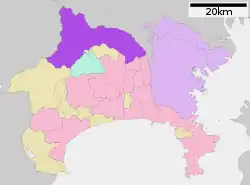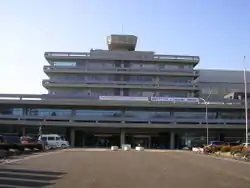Sagamihara
Sagamihara (相模原市, Sagamihara-shi) is a city in Kanagawa Prefecture, Japan. It is the third-most-populous city in the prefecture, after Yokohama and Kawasaki, and the fifth most populous suburb of the Greater Tokyo Area. Its northern neighbor is Machida, with which a cross-prefectural merger has been proposed.[1]
Sagamihara
相模原市 | |
|---|---|
| Sagamihara City | |
 From top left: Tanzawa mountains, USARJ Sagami General Depot, Lake Sagami, Hashimoto District, Odakyu Sagami-Ōno Station, JAXA Sagamihara Campus, Sakura Festival | |
 Flag  Seal | |

| |
 Location of Sagamihara in Kanagawa Prefecture | |
 Sagamihara | |
| Coordinates: 35°34′N 139°22′E | |
| Country | Japan |
| Region | Kantō |
| Prefecture | Kanagawa Prefecture |
| First official recorded | 741 AD |
| City Settled | November 20, 1954 |
| Government | |
| • Mayor | Kentaro Motomura |
| Area | |
| • Total | 328.91 km2 (126.99 sq mi) |
| Population (April 1, 2017) | |
| • Total | 720,986 |
| • Density | 2,200/km2 (5,700/sq mi) |
| Time zone | UTC+9 (Japan Standard Time) |
| – Tree | Zelkova serrata |
| – Flower | Hydrangea |
| – Bird | Skylark |
| Phone number | 042-754-1111 |
| Address | 2-11-15 Chūō, Chūō-ku, Sagamihara-shi, Kanagawa-ken 252-5277 |
| Website | city |
As of April 1, 2017, the city has an estimated population of 720,986, with 316,648 households,[2] and a population density of 2,200 persons per km². The total area is 328.91 km².[3]
On April 1, 2010, the city became the 19th city designated by government ordinance. As a result of this, three wards were established: Midori-ku, Chūō-ku and Minami-ku.
History


The area of modern Sagamihara has been settled since ancient times, and has a number of remains from the Japanese Paleolithic period and Kofun period have been found. It was home to the Yokoyama clan, one of the seven warrior clans of the Musashi region during the early Kamakura period. During the Edo period, the lands around Sagamihara were tenryō territory theoretically administered directly by the Tokugawa Shogunate in Edo; however, in reality, the area was a patchwork of small fiefs held by various hatamoto, as well as exclaves under the control of the Ogino-Yamanaka Domain and Karasuyama Domain.
After the Meiji Restoration, the eastern portion was part of Kōza District, and the western portion was part of Tsukui District. The Kōza District portion was administratively divided into six villages on April 1, 1889. The area was the location of extensive training facilities and arsenals of the Imperial Japanese Army during the 1930s. These villages were merged on April 29, 1941, together with neighboring Zama Town to create Sagamihara Town. At the time of its formation, it was the largest town in Japan in terms of area.
On September 1, 1948, Zama was administratively separated into Zama Town. The remaining portion became Sagamihara City on November 20, 1954. The city population had grown steadily, partly due to local industrial development, and partly due to the city's excellent transportation infrastructure connecting it to Yokohama, Tokyo and Hachiōji. It was designated a core city with increased autonomy in 2003.
On March 20, 2006, Sagamihara absorbed the towns of Tsukui and Sagamiko (both from Tsukui District). The merged city consisted of two geographically separate areas, as two other towns of Tsukui District (Fujino and Shiroyama) elected to remain separate. A further merger on March 11, 2007, joined Fujino and Shiroyama with Sagamihara, thus geographically unifying the city, and dissolving former Tsukui District. In 2007, the population of Sagamihara exceeded 700,000. In 2010, Sagamihara was redesignated as a government ordinance city and split into 3 wards Midori-ku, Chūō-ku, and Minami-ku.
On July 25, 2016, 19 people were killed and 26 injured in a mass stabbing incident at a disabled care home in the city by Satoshi Uematsu, the perpetrator.[4]
Geography
Sagamihara covers a large area of northwestern Kanagawa Prefecture. The main areas of commercial activity in Sagamihara are located near Hashimoto Station on the JR East Yokohama Line and Keio Sagamihara Line; Sagamihara Station on the Yokohama Line; and Sagami-Ōno Station on the Odakyu Odawara Line. Western Sagamihara is within the Tanzawa Mountains.
Transportation

Rail
- JR East – Yokohama Line
- Kobuchi – Fuchinobe – Yabe – Sagamihara – Hashimoto
- JR East – Sagami Line
- Sōbudai-shita – Shimomizo – Harataima – Banda – Kamimizo – Minami-Hashimoto – Hashimoto
- JR East – Chūō Main Line
- Odakyu Electric Railway – Odakyu Odawara Line
- Keio Corporation – Sagamihara Line
- Hashimoto
Tourist attractions
- Sagami Lake
- Yōgen Temple (妙現寺), built in 1598
- Sagamihara Prefectural Park
Sister cities
.svg.png.webp) Toronto, Ontario, Canada since January 1, 1998
Toronto, Ontario, Canada since January 1, 1998.svg.png.webp) Trail, British Columbia, Canada, since April 15, 1991
Trail, British Columbia, Canada, since April 15, 1991 Wuxi, Jiangsu, China, since October 6, 1985
Wuxi, Jiangsu, China, since October 6, 1985
Notable people from Sagamihara
- Jin Akimoto, Japanese retired mixed martial artist
- Jiro Akama, Japanese politician
- Hiroko Anzai, Japanese actress, model and gravure idol
- Hayato Arakaki, Japanese professional baseball pitcher and player (Hokkaido Nippon-Ham Fighters, Nippon Professional Baseball – Pacific League)
- Akira Asahara, Japanese professional Magic: The Gathering player
- Nana Eikura, Japanese model, actress, and radio show host
- Tsuneo Enari, Japanese photographer
- Masato Fukae, Japanese professional baseball outfielder
- Tatsunori Hara, Japanese baseball manager (Yomiuri Giants, Nippon Professional Baseball)
- Tasuku Hatanaka, Japanese actor, voice actor and singer
- Yūki Himura, Japanese comedian, actor and voice actor
- Akiko Ichikawa, Japanese American interdisciplinary artist, editor, writer and activist
- Akira Iida,Japanese racing driver (Super GT)
- Yuki Tsunoda,Japanese racing driver (Formula 1)
- Yu Inaba, Japanese actor (Kamen Rider Drive)
- Megumi Inoue, Japanese sport shooter
- Yōzaburō Kanari, Japanese manga story writer (Kindaichi Case Files)
- Tsutomu Kashiwakura, Japanese voice actor and sound director
- Ukyo Katayama, Japanese former racing driver and team manager
- Tsuyoshi Kawagishi, former Nippon Professional Baseball pitcher (Tohoku Rakuten Golden Eagles, Pacific League)
- Hidetaka Kawagoe, former Nippon Professional Baseball pitcher
- Tsuyoshi Kikuchihara, Japanese former baseball player
- Yuna Kotani, Japanese female curler
- Keiichiro Koyama, Japanese idol and musician, leader of NEWS
- Tomoyoshi Koyama, Japanese professional motorcycle road racer
- Togi Makabe, Japanese professional wrestler (New Japan Pro-Wrestling)
- Ayako Nishikawa, female TV star, tarento, comedian, and cosmetic surgeon
- Hiroyuki Nishimura, Japanese internet entrepreneur, self-help author and TV personality
- Yukio Ozaki, Japanese politician
- Kenji Ozawa, Japanese world-famous conductor
- Ryo Aitaka, Japanese heavyweight kickboxer
- Makoto Sasamoto, Japanese Greco-Roman wrestler
- Shin'ya Satō, Japanese professional shogi player ranked 7-dan
- Ryōichi Sekiya, Japanese ultramarathon and marathon runner
- Shinya Tasaki, Japanese sommelier
- Ai Tominaga, Japanese fashion model and actress
- Momo Watanabe, Japanese professional wrestler (World Wonder Ring Stardom)
- Yuuya Watanabe, Japanese professional Magic: The Gathering player
- Mika Yoshikawa, Japanese middle- and long-distance runner
References
- Merger proposal (in Japanese) (Translate to English: Google, Bing)
- "Official website of Sagamihara City" (in Japanese). Japan: Sagamihara City. Retrieved May 5, 2017.
- "Overview of Sagamihara City" (in Japanese). Japan: Sagamihara City. Retrieved May 5, 2017.
- McCurry, Justin (July 26, 2016). "Japan Knife Attack: Stabbing at Care Centre Leaves 19 Dead and Dozens Wounded". The Guardian. Guardian News and Media. Retrieved July 26, 2016.
| Wikivoyage has a travel guide for Sagamihara. |
External links
| Wikimedia Commons has media related to Sagamihara, Kanagawa. |
- Official Website (in Japanese)
 Geographic data related to Sagamihara at OpenStreetMap
Geographic data related to Sagamihara at OpenStreetMap